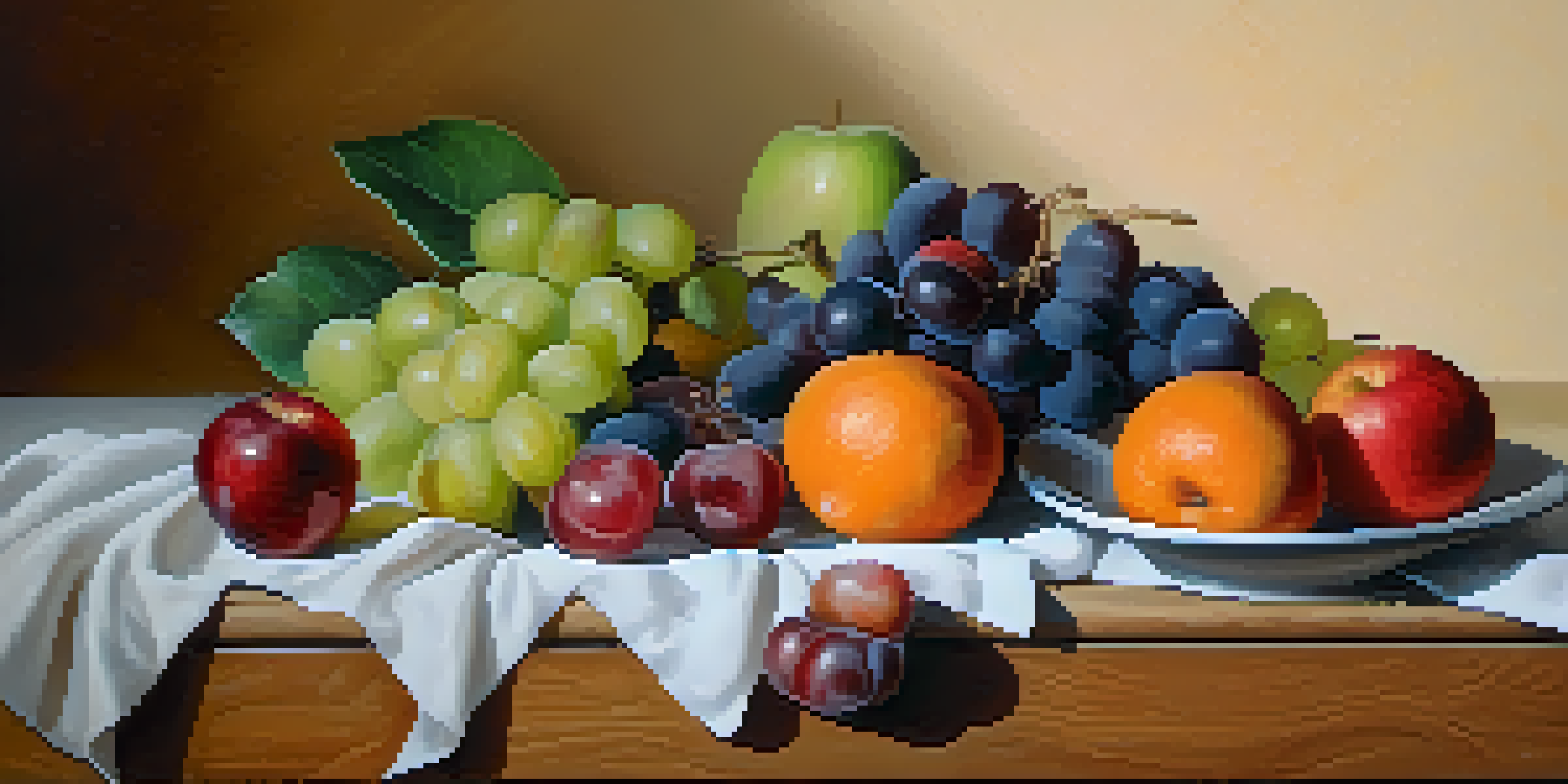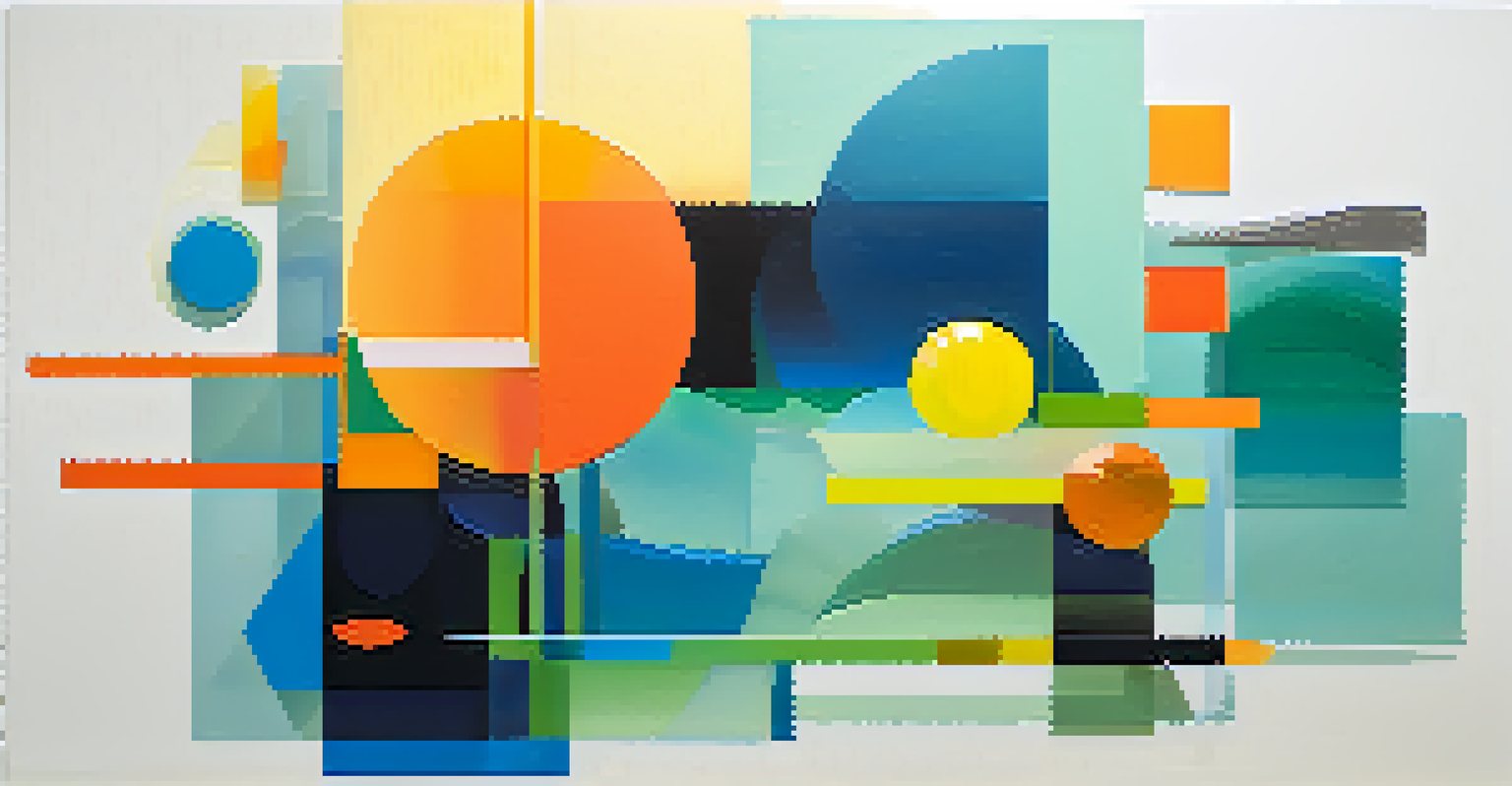Exploring Negative Space Techniques in Painting

Understanding Negative Space: The Basics
Negative space refers to the area around and between the subjects of an image. It’s not just empty space; it plays a crucial role in the overall composition. By focusing on negative space, artists can create balance and harmony in their paintings, drawing attention to the main subjects.
Negative space is the background that makes the foreground stand out.
Think of negative space as the invisible framework that holds your artwork together. Just like a well-structured story needs setting and context, a painting needs negative space to guide the viewer’s eye. This concept can help artists think outside the box, allowing their creativity to flourish.
For example, consider a still life painting of fruits on a table. The fruits are the subjects, but the space around them helps define their shapes and colors, making them stand out. By mastering the use of negative space, artists can enhance their work, creating more impactful and engaging pieces.
The Importance of Composition in Art
Composition is the arrangement of elements within a work of art, and negative space is a key component. A well-composed piece will have a balance of positive (the subjects) and negative space, making it visually appealing. This balance helps to guide the viewer’s eye and creates a sense of flow throughout the artwork.

Imagine a painting where the subjects are crowded together without any breathing room; it may feel chaotic and overwhelming. In contrast, an artwork that thoughtfully incorporates negative space can evoke feelings of calmness and clarity. Good composition invites viewers to explore the piece fully.
Negative Space Enhances Composition
Utilizing negative space is essential for achieving balance and harmony in artwork.
Using techniques like the Rule of Thirds or the Golden Ratio can help artists effectively utilize negative space in their compositions. These principles encourage artists to strategically place subjects and leave space, creating a more dynamic and engaging visual experience.
Techniques to Identify Negative Space
One effective way to identify negative space is to squint at your painting. This technique allows you to see the shapes created by the space around your subjects more clearly. When you squint, you’ll notice the outlines of the negative space, which can help you adjust your composition for better balance.
Composition is the master key to the art of painting.
Another approach is to take a photo of your painting and convert it to black and white. This process eliminates color distractions and emphasizes the shapes created by negative space. By analyzing these shapes, artists can refine their designs and improve overall composition.
Lastly, try sketching the negative spaces instead of the subjects themselves. This shift in focus can provide a fresh perspective, allowing artists to see their work in an entirely new light. By practicing these techniques, you’ll become more adept at recognizing and utilizing negative space in your paintings.
Using Color to Enhance Negative Space
Color plays a vital role in highlighting negative space. A well-chosen color palette can create a strong contrast between the subjects and the background, making the negative space more pronounced. For instance, using a darker color for the background can make lighter subjects pop, drawing the viewer's attention.
Additionally, warm and cool colors can evoke different emotions within the negative space. Warm colors tend to convey energy and excitement, while cool colors can suggest calmness and tranquility. By understanding the emotional impact of color, artists can make deliberate choices to enhance their artwork.
Color Amplifies Negative Space Impact
Choosing the right color palette can highlight negative space, making it a dynamic part of the composition.
Experimenting with gradients and texture in negative space can also add depth and interest. By incorporating these elements, artists can transform negative space from an overlooked area into a dynamic part of the composition, enriching the overall painting.
Incorporating Negative Space into Your Style
Every artist has a unique style, and negative space can be tailored to fit yours. Whether you prefer realism, abstraction, or anything in between, integrating negative space thoughtfully can elevate your work. For example, an abstract artist might use negative space to create striking shapes and forms, while a realist might use it to enhance lifelike subjects.
To find your individual voice, study the work of artists who effectively use negative space. Look for inspiration in various styles and genres, noting how they incorporate this technique. This exploration can spark new ideas and encourage you to experiment with your own approach.
As you begin to incorporate negative space into your style, don’t be afraid to break the rules. Art is about expression, and sometimes the most compelling pieces arise from unexpected choices. Trust your instincts and allow your creativity to guide you as you navigate negative space in your work.
Common Mistakes to Avoid with Negative Space
While negative space can enhance a painting, there are common pitfalls that artists should be aware of. One mistake is neglecting negative space altogether, leading to overcrowded compositions that lack balance. Remember, negative space is just as important as the subjects themselves, so give it the attention it deserves.
Another common error is misjudging the shapes of negative space. This can result in awkward or unintentional forms that disrupt the flow of the artwork. It’s essential to take the time to analyze and adjust the negative space during the painting process to ensure a cohesive composition.
Practice is Key to Mastery
Regular practice and experimentation with negative space techniques can significantly improve an artist's compositional skills.
Finally, be cautious not to let negative space dominate the painting. While it’s crucial for balance, too much negative space can leave the artwork feeling incomplete. Strive for a harmonious blend of positive and negative space to create a captivating piece that draws viewers in.
Practicing Negative Space Techniques
Like any skill, mastering negative space takes practice. Set aside time to experiment with different techniques, such as drawing or painting solely negative spaces. This practice will help you become more comfortable with the concept and improve your overall compositional skills.
Consider joining a local art group or taking classes focused on negative space techniques. Collaborating with fellow artists can provide valuable feedback and inspire new ideas. Plus, learning from others' experiences can help you avoid common mistakes and refine your own approach.

Lastly, don’t forget to keep a sketchbook handy. Regularly sketching your surroundings with a focus on negative space can sharpen your observational skills. The more you practice, the more intuitive your understanding of negative space will become, ultimately enhancing your painting technique.